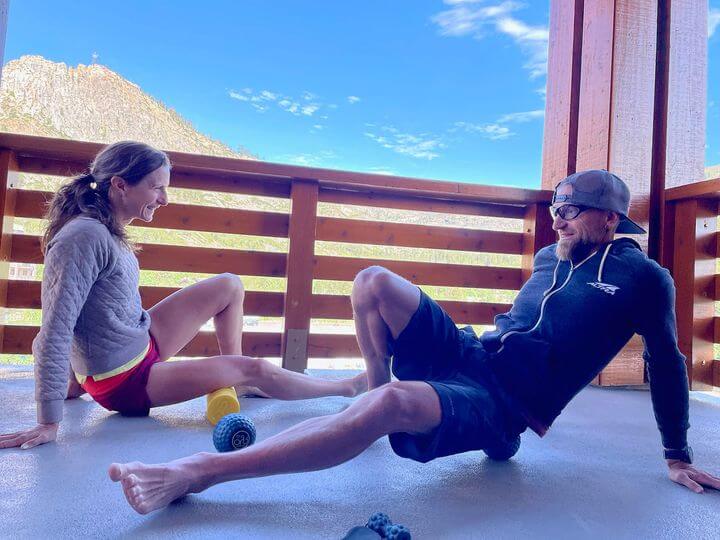
By Jeff Browning
As the years pass, there are few things that impact sport longevity like loss of strength and mobility. Losing muscle mass (and therefore power) and a shorter muscular range of motion sets us up for injury or setback and a marked decline in longevity. It can happen to the best of us. But it doesn’t have to.
If running longevity is a goal (and isn’t it always?), you need to prioritize strength, mobility work, and nutrition. Here’s how.
Mobility
Use it or lose it. Better mobility equates to better range of motion and freedom of movement. Mobility work will improve your circulation, decrease your risk of injury, and reduce muscle tension and soreness. This all leads to better movement efficiency. There are two strategies I use to improve runner mobility: active stretching and foam rolling.
Foam rolling increases blood flow and circulation to soft tissue, relieves tight fascia, and breaks up adhesions (trigger points) in the muscle. It can also lead to an improvement in range of motion and flexibility. This in turn can help your muscles return to homeostasis so they can function normally again. In other words, foam rolling can result in faster recovery.
Active stretching is the balance of passive range of motion (flexibility) and active range of motion (mobility). The balance between these two are important to facilitate proper, efficient movement patterns. This means stability during muscle recruitment. Here’s an example of a mobility warm-up:
Progressive movements. First three are standing, the rest are walking. 12 reps (or 6 each side):
Side lunge with overhead arm reach
- Alternating figure 4 squat
- Air squat
- Walking lunge
- Walking wide lunge
- Walking lunge with trunk twist
- Sumo walk
Once you establish good mobility, you’re ready to move on to strength training.
Strength
Let’s talk about running through the lens of the hormonal process. Running is a catabolic effect. Catabolic means “to break down.” When you’re younger, this isn’t a big issue because the recovery process rebuilds your muscle. However, the recovery process and protein synthesis slow down as you age, especially after 40. As the years pass, there are fewer hormones and less protein synthesized to get the job done.
The inverse of catabolic is anabolic, which means “building up.” The simple strategy for a youthful infusion into your run training is strength training. Lifting weights will create a surge in anabolic hormones (both testosterone and human growth hormone). Lifting weights also increases mitochondrial density (the energy factory of the cells). In short, strength training will complement your running.
Nutrition
Another component in the longevity game is nutrient-dense foods, with protein intake being the focus. I personally adhere to a nutrivore diet. Protein should be a constant in our meals with a balance of good fats and whole food carbohydrates like fruit, veggies and tubers (sweet potato, yams, etc.). As previously mentioned, protein synthesis slows down as we age. So increasing protein intake can help offset that natural aging progression. I shoot for 80-100% of my body weight in grams of protein per day. (For example, someone weighing 140 pounds would aim to intake 112 to 140 grams of protein per day.)
Getting older doesn’t have to mean retiring to a life of inactivity and ice cream. With a little diligence and focus on these three strategies, you’ll be impressing your peers with a lean, muscular physique while simultaneously decreasing your risk of injury and aiding your recovery. Running long will take on a whole new meaning. Giddyup!
About the Author
Jeff Browning is a veteran ultra runner, ultra endurance coach and ProTec Athlete. You can learn more about him, his adventures, and his coaching at GoBroncoBilly.com or Instagram: @GoBroncoBilly
